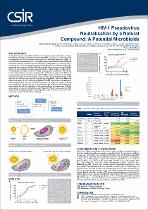JavaScript is disabled for your browser. Some features of this site may not work without it.
- ResearchSpace
- →
- Research Publications/Outputs
- →
- Conference Publications
- →
- View Item
| dc.contributor.author |
Van den Berg, N

|
|
| dc.contributor.author |
Mbobela, P

|
|
| dc.contributor.author |
Pillay, P

|
|
| dc.contributor.author |
London, G

|
|
| dc.contributor.author |
Morris, L

|
|
| dc.contributor.author |
Maharaj, V

|
|
| dc.contributor.author |
Khati, M

|
|
| dc.date.accessioned | 2011-07-08T10:50:44Z | |
| dc.date.available | 2011-07-08T10:50:44Z | |
| dc.date.issued | 2011-02 | |
| dc.identifier.citation | Van den Berg, N, Mbobela, P, Pillay, P et al. 2011. HIV-1 pseudovirus neutralisation by a natural compound: a potential microbicide. EMBO Global exchange lecture course, Wallenberg Research Centre, Stellenbosch, February 2011 | en_US |
| dc.identifier.uri | http://hdl.handle.net/10204/5091 | |
| dc.description | EMBO Global exchange lecture course, Wallenberg Research Centre, Stellenbosch, February 2011 | en_US |
| dc.description.abstract | A natural compound isolated from extracts of an indigenous plant in the Eastern Cape, South Africa, indicates neutralisation activity against HIV-1 pseudoviruses. This natural compound can potentially be used in a microbicide as an alternative means to prevent the spread of HIV and AIDS. The compound’s neutralisation activity (IC50 0.05-7.2µg/mL) is comparable with that of the entry inhibitor T-20 (IC50 0.05-2.94µg/mL) and the reverse transcriptase inhibitor Tenofovir (IC50 0.09-0.83µg/mL) when screened against the NIH reference panel for HIV-1 subtype C envelope molecular clones. T20 is a more relevant drug for comparative purposes as it is an entry inhibitor and indications on our compound of interest point to it also acting in a similar manner. The mode of action of the compound is, however, yet to be determined. The aim is to develop a microbicide based on an indigenous plant for people infected with HIV-1. The compound will also be screened against other HIV-1 subtypes to test the neutralisation breadth. The authors have shown that the extracts of the plant and the compound are not cytotoxic towards TZM-bl cells when tested in a MTT assay at concentrations up 100 µg/mL. In addition these did not show any neutralisation activity against VSV-G which has a similar glycoprotein to HIV-1 indicating specificity to HIV-1. | en_US |
| dc.language.iso | en | en_US |
| dc.publisher | CSIR | en_US |
| dc.relation.ispartofseries | Workflow; 5451 | |
| dc.subject | Natural compounds | en_US |
| dc.subject | HIV-1 | en_US |
| dc.subject | HIV-1 pseudovirus neutralisation | en_US |
| dc.subject | Neutralisation activity | en_US |
| dc.subject | Indigenous plants | en_US |
| dc.title | HIV-1 pseudovirus neutralisation by a natural compound: a potential microbicide | en_US |
| dc.type | Conference Presentation | en_US |
| dc.identifier.apacitation | Van den Berg, N., Mbobela, P., Pillay, P., London, G., Morris, L., Maharaj, V., & Khati, M. (2011). HIV-1 pseudovirus neutralisation by a natural compound: a potential microbicide. CSIR. http://hdl.handle.net/10204/5091 | en_ZA |
| dc.identifier.chicagocitation | Van den Berg, N, P Mbobela, P Pillay, G London, L Morris, V Maharaj, and M Khati. "HIV-1 pseudovirus neutralisation by a natural compound: a potential microbicide." (2011): http://hdl.handle.net/10204/5091 | en_ZA |
| dc.identifier.vancouvercitation | Van den Berg N, Mbobela P, Pillay P, London G, Morris L, Maharaj V, et al, HIV-1 pseudovirus neutralisation by a natural compound: a potential microbicide; CSIR; 2011. http://hdl.handle.net/10204/5091 . | en_ZA |
| dc.identifier.ris | TY - Conference Presentation AU - Van den Berg, N AU - Mbobela, P AU - Pillay, P AU - London, G AU - Morris, L AU - Maharaj, V AU - Khati, M AB - A natural compound isolated from extracts of an indigenous plant in the Eastern Cape, South Africa, indicates neutralisation activity against HIV-1 pseudoviruses. This natural compound can potentially be used in a microbicide as an alternative means to prevent the spread of HIV and AIDS. The compound’s neutralisation activity (IC50 0.05-7.2µg/mL) is comparable with that of the entry inhibitor T-20 (IC50 0.05-2.94µg/mL) and the reverse transcriptase inhibitor Tenofovir (IC50 0.09-0.83µg/mL) when screened against the NIH reference panel for HIV-1 subtype C envelope molecular clones. T20 is a more relevant drug for comparative purposes as it is an entry inhibitor and indications on our compound of interest point to it also acting in a similar manner. The mode of action of the compound is, however, yet to be determined. The aim is to develop a microbicide based on an indigenous plant for people infected with HIV-1. The compound will also be screened against other HIV-1 subtypes to test the neutralisation breadth. The authors have shown that the extracts of the plant and the compound are not cytotoxic towards TZM-bl cells when tested in a MTT assay at concentrations up 100 µg/mL. In addition these did not show any neutralisation activity against VSV-G which has a similar glycoprotein to HIV-1 indicating specificity to HIV-1. DA - 2011-02 DB - ResearchSpace DP - CSIR KW - Natural compounds KW - HIV-1 KW - HIV-1 pseudovirus neutralisation KW - Neutralisation activity KW - Indigenous plants LK - https://researchspace.csir.co.za PY - 2011 T1 - HIV-1 pseudovirus neutralisation by a natural compound: a potential microbicide TI - HIV-1 pseudovirus neutralisation by a natural compound: a potential microbicide UR - http://hdl.handle.net/10204/5091 ER - | en_ZA |






